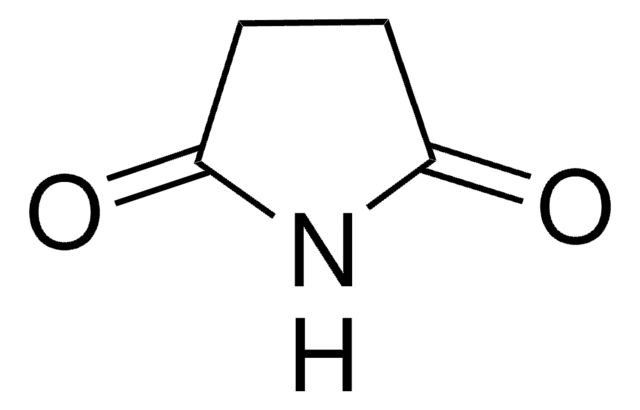11709
Barbituric acid
for spectrophotometric det. of cyanide, ≥99.5%
Synonyme(s) :
2,4,6-Trihydroxypyrimidine, Malonylurea
About This Item
Produits recommandés
Niveau de qualité
Pureté
≥99.5% (HPLC)
≥99.5%
Forme
solid
Qualité
for spectrophotometric det. of cyanide
Technique(s)
UV/Vis spectroscopy: suitable
Résidus de calcination
≤0.05%
Pf
248-252 °C (dec.) (lit.)
Traces d'anions
chloride (Cl-): ≤50 mg/kg
sulfate (SO42-): ≤500 mg/kg
Traces de cations
Ca: ≤10 mg/kg
Cd: ≤5 mg/kg
Co: ≤5 mg/kg
Cr: ≤5 mg/kg
Cu: ≤5 mg/kg
Fe: ≤5 mg/kg
Mg: ≤10 mg/kg
Mn: ≤5 mg/kg
Ni: ≤5 mg/kg
Pb: ≤5 mg/kg
Zn: ≤5 mg/kg
Chaîne SMILES
O=C1CC(=O)NC(=O)N1
InChI
1S/C4H4N2O3/c7-2-1-3(8)6-4(9)5-2/h1H2,(H2,5,6,7,8,9)
Clé InChI
HNYOPLTXPVRDBG-UHFFFAOYSA-N
Vous recherchez des produits similaires ? Visite Guide de comparaison des produits
Catégories apparentées
Description générale
Application
Code de la classe de stockage
11 - Combustible Solids
Classe de danger pour l'eau (WGK)
WGK 1
Point d'éclair (°F)
302.0 °F - closed cup
Point d'éclair (°C)
150.00 °C - closed cup
Équipement de protection individuelle
Eyeshields, Gloves, type N95 (US)
Choose from one of the most recent versions:
Déjà en possession de ce produit ?
Retrouvez la documentation relative aux produits que vous avez récemment achetés dans la Bibliothèque de documents.
Les clients ont également consulté
Notre équipe de scientifiques dispose d'une expérience dans tous les secteurs de la recherche, notamment en sciences de la vie, science des matériaux, synthèse chimique, chromatographie, analyse et dans de nombreux autres domaines..
Contacter notre Service technique







![Cyanide standard solution traceable to SRM from NIST K₂[Zn(CN)₄] in H₂O 1000 mg/l CN Certipur®](/deepweb/assets/sigmaaldrich/product/images/920/032/af45eec3-100b-4996-8eb3-c3942d441bc9/640/af45eec3-100b-4996-8eb3-c3942d441bc9.jpg)




